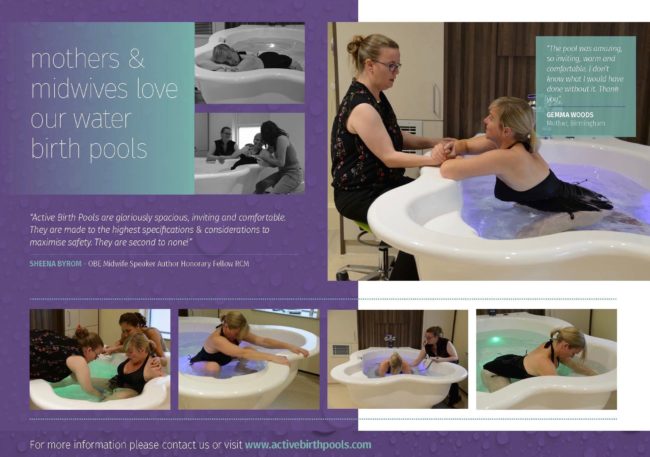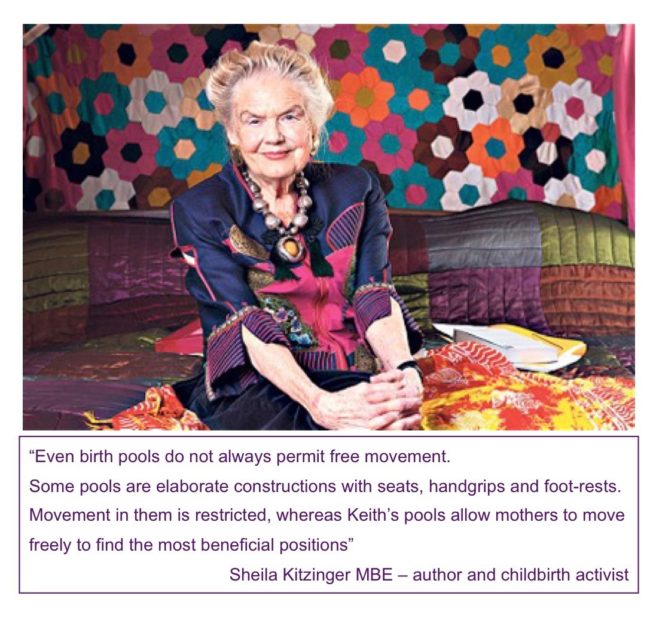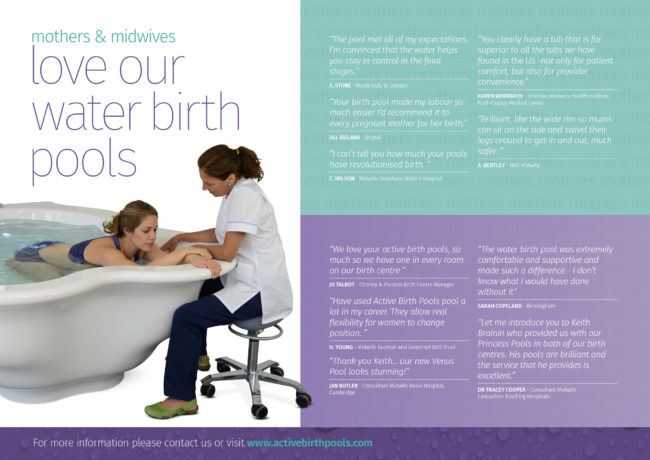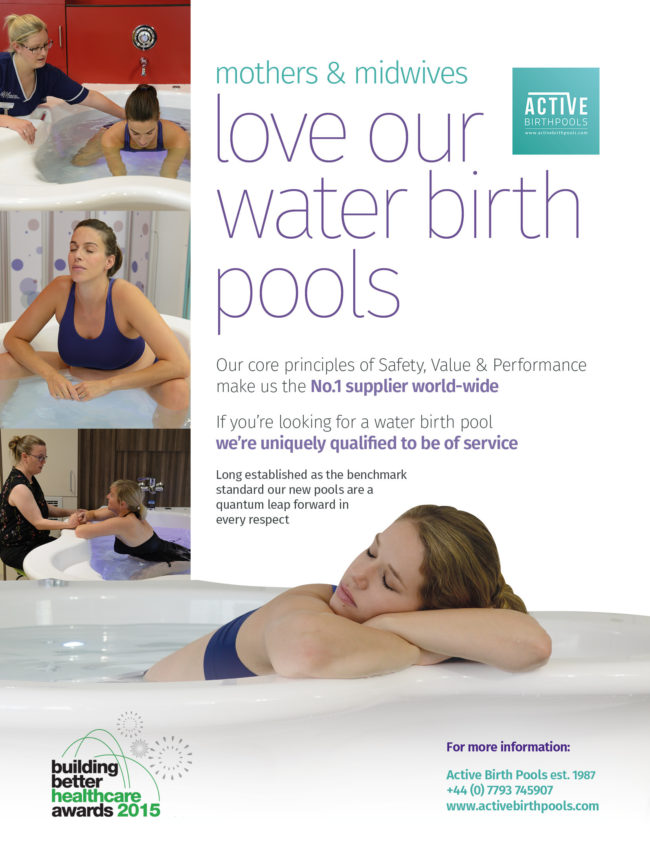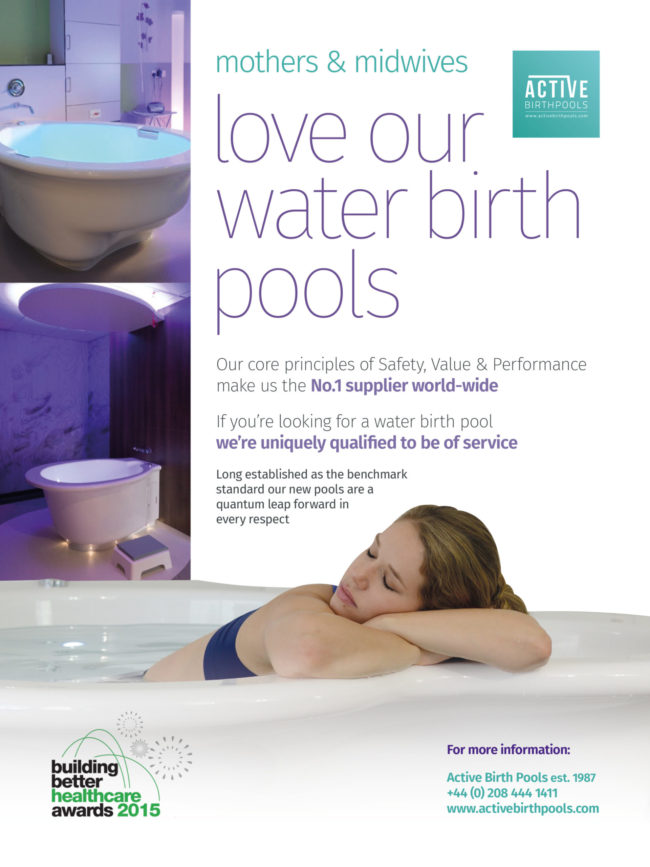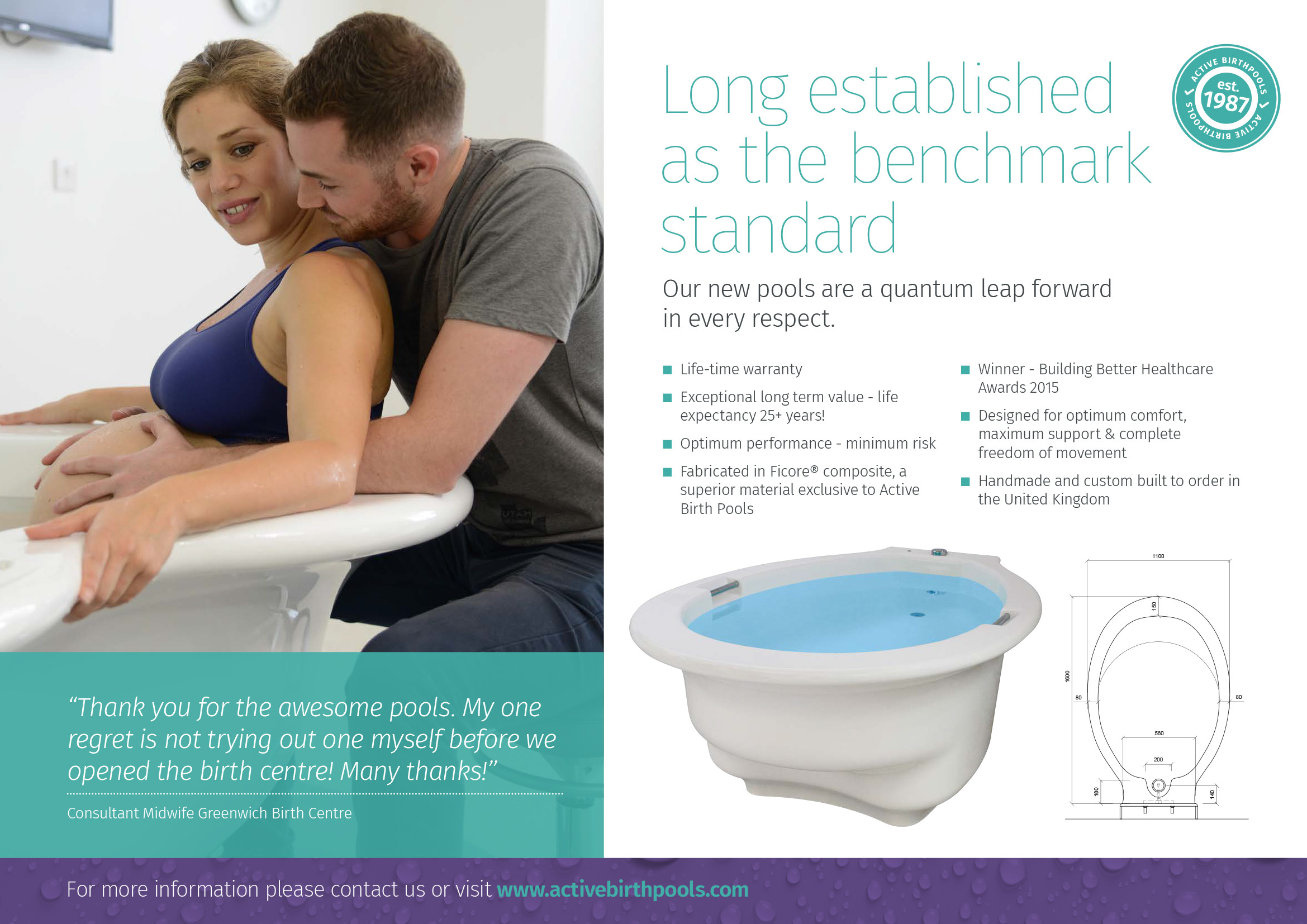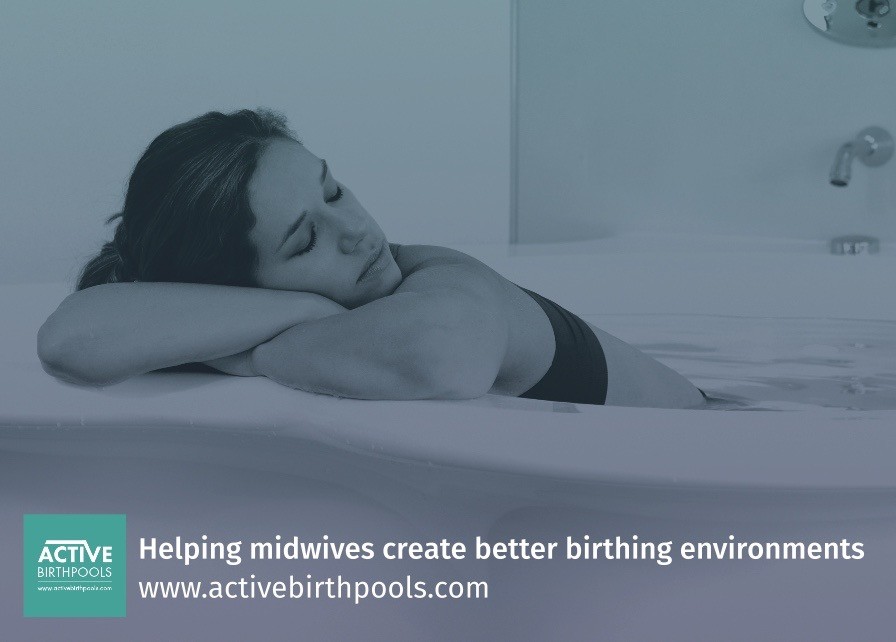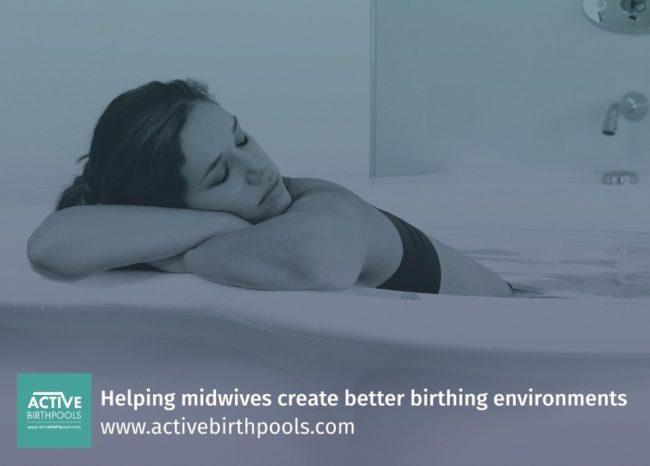Barbara Harper 2000
Waterbirth is simple.
Within the simplicity of water labor and birth lies a complexity of questions, choices, opinions, research data, women’s experience and practitioner observations.
Over the past five years, as more hospitals within the United States examined waterbirth and created programs to support the use of water for labor and birth, newspaper reporters latched onto the sensationalism of this simple option and published stories of successful waterbirths in local publications.
Reporters do their best to simplify waterbirth and at the same time answer the most common questions. Each story shows a happy, beaming mother, a quiet, peaceful baby and a proud father, who usually successfully sets up a portable birth pool.
The surprise headlines like “Watery Birth” or “Baby’s Birth Goes Swimmingly” or “Junior Makes a Splashy Entrance” are countered with the simple stories of couples who have made this decision for themselves and are proud of it.
The first and foremost question in everyone’s mind and the lead in all these newspaper accounts is simple: How does the baby breathe during a waterbirth?
Inhibitory Factors
Several factors prevent a baby from inhaling water at the time of birth. These inhibitory factors are normally present in all newborns. The baby in utero is oxygenated through the umbilical cord via the placenta, but practices for future air breathing by moving his/her intercostal muscles and diaphragm in a regular and rhythmic pattern from about ten weeks gestation on.
The lung fluids that are present are produced in the lungs and are similar chemically to gastric fluids. These fluids come up into the mouth and are normally swallowed by the fetus. There is very little inspiration of amniotic fluid in utero.
Twenty-four to forty-eight hours before the onset of spontaneous labor, the fetus experiences a notable increase in the prostaglandin E2 levels from the placenta which causes a slowing down or stopping of the fetal breathing movements (FBM).1 With the work of the musculature of the diaphragm and intercostal muscles suspended, there is more blood flow to vital organs, including the brain.
You can see the decrease in FBM on a biophysical profile, as you normally see the fetus moving these muscles about 40 percent of the time. When the baby is born and the prostaglandin level is still high, the baby’s muscles for breathing simply don’t work, thus engaging the first inhibitory response.
A second inhibitory response is the fact that babies are born experiencing acute hypoxia or lack of oxygen. It is a built-in response to the birth process. Hypoxia causes apnea and swallowing, not breathing or gasping.
If the fetus were experiencing severe and prolonged lack of oxygen, it may then gasp as soon as it was born, possibly inhaling water into the lungs.2 If the baby were in trouble during the labor, there would be wide variabilities noted in the fetal heart rate, usually resulting in prolonged bradycardia, which would cause the practitioner to ask the mother to leave the bath prior to the baby’s birth.
The temperature differential is another factor thought by many to inhibit the newborn from initiating the breathing response while in water. The temperature of the water is so close to maternal temperature that it prevents any detection of change within the newborn.
This is an area for reconsideration after increasing reports of births taking place in the oceans, both now and in eras past. Ocean temperatures are certainly not as high as maternal body temperature, yet babies that are born in these environments are reported to be just fine. The lower water temperatures do not stimulate the baby to breathe while immersed.
One more factor that most people do not consider but which is vital to the whole waterbirth and aspiration issue is the fact that water is a hypotonic solution and lung fluids present in the fetus are hypertonic. Even if water were to travel in past the larynx, it could not pass into the lungs based on the fact that hypertonic solutions are denser and prevent hypotonic solutions from merging or coming into their presence.
The last important inhibitory factor—the dive reflex—is associated with the larynx. The larynx is covered all over with chemoreceptors, or taste buds. In fact, the larynx has five times as many taste buds as the whole surface of the tongue.
When a solution hits the back of the throat and crosses the larynx, the taste buds interpret what substance it is and the glottis automatically closes; the solution is then swallowed, not inhaled.3
God built this autonomic reflex into all newborns to help them breastfeed, and it is present until about the age of six to eight months when it mysteriously disappears. The newborn is very intelligent and can detect what substance is in its throat.
It can differentiate between amniotic fluid, water, cow’s milk or human milk. The human infant will swallow and breathe differently when feeding on cow’s milk or breastmilk due to the dive reflex.
All these factors combine to prevent a newborn who is born into water from taking a breath until he is lifted up into the air.
Baby’s First Breath
What initiates the breath in the newborn? As soon as the newborn senses a change in the environment from the water into the air, a complex chain of chemical, hormonal and physical responses initiate the baby’s first breath.
Water born babies are slower to initiate this response because their whole body is exposed to the air at the same time, not just the caput or head as in a dry birth. Many midwives report that water babies stay a little bit bluer longer, but their tone and alertness are just fine. It has even been suggested that water born babies be given the first APGAR scoring at one minute thirty seconds, not at one minute, because of this adjustment.
Several things happen all at once in the baby. The shunts in the heart are closed; fetal circulation turns to newborn circulation; the lungs experience oxygen for the first time; and the umbilical cord is stretched causing the umbilical arteries to close down.
Nursing and medical schools taught their students for years that the first breath was dependent on the pressure of the passage through the birth canal, and then a reflexive opening of the compressed chest creating a vacuum.
That action has no bearing on newborn breathing whatsoever. There is no vacuum created. The newborn born into water is protected by all the inhibitory mechanisms mentioned above and is suspended and waiting to be lifted out of the water and into mother’s waiting arms.
All the fluids present in the lung alveoli are automatically pushed out into the vascular system from the pressure of pulmonary circulation, thus increasing blood volume for the newborn by one-fifth (or 20 percent).
The lymphatic system absorbs the rest of the fluids through the interstitial spaces in the lung tissue. The increase of blood volume is vital for the baby’s health. It takes about six hours for all the lung fluids to disappear.4
Outcomes and Concerns
When we look back at the analysis of the statistics of babies born in water it proves that these inhibitory factors are more than theories. A study conducted in England between 1994 and 1996 and published in 1999 reports on the outcomes of 4,032 births in water. Perinatal mortality was 1.2 per 1,000, but no deaths were attributed to birth in the water. Two babies were admitted to special care for possible water aspiration.5
It is estimated that there have been well over 150,000 waterbirths worldwide between 1985 and 1999. There are no valid reports of infant deaths due to water aspiration or inhalation. In the early days of waterbirth a baby was reported to have died from being born in the water.
This particular newborn death was caused not by aspiration, but by asphyxiation because the baby was left under the water for more than fifteen minutes after the full body was born. At some point the placenta detached from the wall of the uterus and stopped the flow of oxygen to the baby.
When the baby was taken out of the water, it did not begin breathing and could not be revived. On autopsy the baby was reported to have no water in the lungs and its death was attributed to asphyxia.6
This is the reason we bring babies up out of the water within the first few moments after birth. Some people have commented on the long time that some babies remain in the water in the film “Water Babies: The Aquanatal Experience in Ostend.” Videotape is deceiving, but so are our senses. When timed, the film sequence is only forty-seven seconds, but when viewers are asked to judge how long the sequence of immersion for the baby really is, reports range anywhere from one minute to five minutes.
Bringing a baby out of the water too quickly can be just as traumatic, but it can also lead to either torn or broken cords. This has been reported by a number of midwives and doctors.7 If the practitioner does not look for a torn cord the possibility of the baby needing a transfusion increases.
Torn or broken cords can be avoided by bringing baby out of the water slowly and gently. Mothers who want to pick up their own babies need to be reminded not to do it too quickly either.
The inability to accurately assess blood loss in the water is a reason given by some midwives for either not “allowing” the birth to take place in the water or asking mother to get out right away after the baby is born. But blood loss is easy to judge after a few births.
Garland and Jones report in a review of waterbirths at Maidstone Hospital in Kent, England, that midwives are much better at judging and reporting blood loss in the water after experiencing over 500 births.8 A useful way to identify the extent of postpartum hemorrhage is how dark the water is getting.
Can you still assess skin color of the mother’s thighs even though there is blood in the water? A few drops of blood in a birth pool diffuse and cause the water to change color. A waterproof flashlight comes in handy at this point.
Dropping a flashlight onto the bottom of the birth pool allows you to look for bleeding as well as meconium during the birth. It also helps you spot floating debris so it can be removed.
This brings us to the second most frequently asked question among hospital nurses and newspaper reporters: Won’t the mother get an infection?
Some hospitals still restrict a woman from laboring in the water if her membranes are ruptured. Based on the current and past literature, this is absurd. No evidence exists of increased infectious morbidity with or without ruptured membranes for women who labor and/or birth in water. 9 ,10
The oldest reference that researches the possibility of infection during a bath is mentioned in a 1960 American Journal of OB/GYN.
Dr. Siegel posed the question, “Does bath water enter the vagina?” In his experiment he placed sterile cotton tampons into thirty women and then asked them to bathe in iodinated water for a minimum of fifteen minutes.
In all cases when the tampons were removed, there was no iodine present.11 His conclusion states, “We can now stop restricting women from bathing in the later stages of pregnancy and labor.”
Laboring mothers have an advantage when the baby is descending and moving out—nothing is moving up and in. Things that we put into laboring vaginas may cause infections, such as probes, fingers, AmnihooksTM, scalp hooks and so on. Janet Rush, RN, and her Canadian group of investigators have conducted the only randomized controlled trial of the effects of water labor.
They reported that there were no differences noted in the low rates of maternal and newborn signs of infection in women with ruptured membranes.12
Infection control, especially in a hospital setting, requires diligence and the attention to strict protocols between and during births. Cleaning and maintaining all equipment used for a waterbirth will prevent the spread of infection.
In a random study conducted at the Oregon Health Science University Hospital in 1999, cultures were done from the portable jetted birth pool before, during and after birth, as well as from the fill hose and water tap source.
In all instances no bacteria was cultured from the birth pool but the water tap did culture Pseudomonas.13 In a British study of 541 water labors, no serious infections were reported during the three-year period of data gathering.
Again, Pseudomonas aeruginosa was the only persistent bacteria discovered in two babies who tested positive from ear swabs. No treatment was necessary.14
Some parents are concerned about mother-to-mother infections or contamination from viruses such as HIV or hepatitis. There is no reason to restrict an HIV-positive mother from laboring or giving birth in water.
All evidence indicates that the HIV virus is susceptible to the warm water and cannot live in that environment.15 Universal precautions still need to be adhered to and proper cleaning of all the equipment after the birth needs to be carried out.
Using disposable liners has become the norm for use with portable birth pools, but attention must also be paid to proper cleaning of drain pumps, hoses, filter nets, taps and any other items that are reused from one birth to the next. The issue of cleaning the jets of permanently installed baths has generated some concern and discussion over the past few years.
Many hospitals remodeled their labor units in the late eighties or early nineties, installing Jacuzzi-type whirlpool baths. These baths are great for women in labor, but often are not deep enough or are situated within very small bathroom spaces, boxed in and making birth in them difficult in all respects.
The protocol for cleaning jetted tubs is simply to completely clean the tub with a quaternary ammonium solution, refill with water and add some kind of brominating agent to circulate through the jet system for a minimum of ten minutes.16
A number of hospitals report that they use a half cup of powdered dish-washing crystals such as Cascade, and it works fine. Lynn Springer, RN, the perinatal coordinator for St. Elizabeth Hospital in Red Bluff, California, chose to install a beautiful corner Jacuzzi brand jetted bath on her unit in 1995.
They have routinely performed monthly cultures of the bath and the jets throughout the past five years of their waterbirth program without any significant bacterial growth. They follow the above-mentioned cleaning protocol and report over 1,000 water labors and 400 births in water.17
When to Enter the Bath
One issue that is repeated in the literature and voiced in the concern of mothers and their midwives is: When should the mother enter the bath?
Many hospitals use the five-centimeter rule, only allowing mothers to enter the bath when they are in active labor and dilated to more than five centimeters.
Some physiological data supports this rule, but each and every situation must be evaluated and then judged. Some mothers find a bath in early labor useful for its calming effect and to determine if labor has actually started.18
The water sometimes slows or stops labor if used too early. On the other hand, if contractions are strong and regular with either a small amount of dilation or none at all, a bath might be in order to help the mother relax enough to facilitate the dilation.
It has been suggested that the bath be used in a “trial of water” for at least one hour, allowing the mother to judge its effectiveness. Women report that often the contractions seem to space out or become less effective if they enter the bath too soon, thus requiring them to leave the bath.
Then again, midwives report that some women can go from one centimeter to complete dilation within the first hour or two of immersion.
Deep immersion seems to be a key factor. If the pool or bath is not deep enough, at least providing water up to breast level and completely covering the belly, then the benefits of the bath may be less noticeable.
The warm water will still provide comfort and the mother will benefit from being upright, in control and drug free, but full immersion promotes more physiological responses, the most notable being a redistribution of blood volume, which stimulates the release of oxytocin and vasopressin.19
Vasopressin can also work to increase the levels of oxytocin.20 The immediate pain reduction felt upon entering the bath is quite noticeable. It is what I refer to as “the ahh effect.”
The smile, the sound and the inner peace that mothers display are unmistakable. This response can happen at any point in the labor, but most notably when contractions are long and strong and close together.
Some midwives who assume there is little or no progress in dilation because the mother is not displaying any outward signs of discomfort are often surprised to find rapid dilation in the first hour of immersion. Having experienced a waterbirth myself, I can verify the incredible difference in perception of pain from the room to the water.
When I am with a woman in labor I generally assess her pain on a scale of one to ten before she enters the bath. Most report at least a six or greater. Then after no less than half an hour, I will make another assessment.
The second subjective answer of course varies from person to person, but the typical response is two to four. The mother is experiencing more than the sum of her physiological responses to warm water immersion. Most women feel inherently safe in the water.
The water creates a wonderful barrier to the outside world. It becomes the woman’s nest, her cave, her own “womb with a view.” If the pool is large enough to include her partner or husband, it then becomes an intimate place for the two of them to labor together and experience the love dance of birth.
If the midwife or physician wants to do a vaginal examination while the mother is in the water, it is much easier for the mother to refuse. Her mobility allows her to move quickly to the other side of the pool. Vaginal exams can be easily done in the water, but to maintain universal precautions, long shoulder-length gloves need to be worn.
The control that women gain by being able to move freely in the water often helps them assess their own progress either by feeling the baby’s movements more intensively or actually being able to examine themselves internally.
Women report that the water intensifies the connection with the baby at the same time that it reduces the pain. They can feel the baby move, descend and push through the birth canal.
The prospect of the midwife becoming an active observer increases as mothers have the ease of mobility in the water and assume more and more responsibility for the birth.
For many reasons, including reducing the risk of infection for the provider, many midwives suggest a hands-off birth for the mother. The water slows the crowning and offers its own perineal support.21 This “minimal-touch” approach also gives the mother a greater sense of controlling her own birth.
Perineal trauma is reported to be generally less severe, with more intact perineums for multips, but in some of the literature about the same frequency of tears for primips in or out of the water.22 23 One of the best benefits of waterbirth is the zero episiotomy rate that is reported throughout the literature.
Rosenthal mentions that episiotomies can be done, but no one else offers this suggestion.7
The combination of being upright, having the mother in a good physiological position to birth her baby, giving her the freedom of control and not telling her to push when her body is not indicating it, all contribute to better perineal outcomes.
The Midwife’s Influence
Midwives have a great deal of influence over the outcome of a birth, from the suggestions they make to a laboring mother to how they handle potential complications. An interesting phenomenon within the waterbirth movement deserves some discussion.
When a mother is laboring undisturbed—about which Odent has written and lectured—she will find her own place and time of birth, whether that place is the bathroom floor, under the piano, on the bed or in the bath.
If practitioners remain silent observers to the process, the baby is born wherever it happens. But when the mother has stated her intentions for a waterbirth and the necessary arrangements have been made to have water available, if then the midwife reminds her as second stage approaches or in the middle of second stage that the bath is ready and waiting if she wants to get back in— is the midwife influencing the mother?
In observing the statistics on waterbirth that Waterbirth International gathers from midwives and doctors, it is hard not to notice the variance from practice to practice.
Those midwives who report an 80 to 90 percent waterbirth rate are usually set up with either a birth center facility that uses easily accessible bathtubs, or every single one of their homebirth clients rent or use portable birth pools.
When the mother is in the midst of her subconscious birth responses and someone tells her that the bath is ready and waiting, she often will immediately dash for the pool and climb in, even in the pushing stage. On occasion she simply states that nothing in heaven and earth can move her beyond where she is.
A midwife’s or physician’s hesitancy for using water for birth can also be felt by the mother and she often acquiesces just to make her practitioner feel more comfortable, instead of following her own instincts and staying in the water. Many women in hospitals get out of the pool because they don’t want to get their midwives “in trouble” by insisting on giving birth in water.
And in the reverse, midwives often must insist that mother get out of the pool because protocols have not been set up for birth or the practitioner is just not comfortable with the process.
The decision to birth in the water should be left up to the mother, but based on sound advice and assessment of fetal well-being by the practitioner. The mother who presents prenatally and insists she is going to have a waterbirth no matter what is usually destined to birth anywhere but the birth pool.
I seriously counsel women who are taking on the system to evaluate their reasons for wanting to birth in water. If they are seeking only to avoid pain, that is a serious red flag and needs to be addressed on many different levels.
If they have experienced one birth already and know what to expect and are looking for a better birth experience, then they are usually open to using the water to be in greater control, and then seeing how they feel at the time of birth.
Flexibility is always required in birth, but especially for those women who add the element of water. In my own case, I wanted to birth in water the first time because I felt it was the best thing I could do for my baby. I hear many women say this, and I consider it a reasonable motivation.
But it is better to focus on the mother and what she needs; the benefit that women derive from being in the water and gaining control over their experience is passed on to the baby. For my second waterbirth, no one could keep me out of the water. I was completely focused on my experience and not the baby’s.
Fathers will often call our office and make all the arrangements for the birth pool rental. On occasion that is because the dad wants his baby to be born in water and no other place, not taking into account what the mother really wants. Usually it all works out just fine, but occasionally it can influence the outcome of the labor.
Protocols
Protocols differ from place to place, but as more experience with waterbirth emerges, we find that some previous reasons for asking a woman to leave the bath prior to birth are no longer hard and fast.
The prescence of meconium used to mean that the mother would have to leave the pool to birth her baby on the bed to facilitate immediate suctioning. This requirement has relaxed a bit as it has been seen that meconium washes off the face of the baby and even comes out of the nares and mouth while the baby is still under the water. DeLee suctioning can still be accomplished as soon as the baby is up in mother’s arms.
Tight nuchal cords were a reason to ask mother to stand for the birth so that the practitioner could cut the cord and then deliver the baby. Now the universal practice is to not even feel for a cord in a waterbirth, unless there has been a very slow second stage and you are afraid of cord compression.
No attempt is made to clamp and cut the cord. The body is birthed and then the cord unwrapped. It is amazing to watch a baby somersault and begin to unwrap its own cord in the expanse of the birth pool.
Breech position was definitely a reason for a more controlled birth or even an automatic cesarean section. But there are practitioners throughout the world who recognize increased safety for the baby if it is born in water.
The most experienced doctor we know is Herman Ponette, an obstetrician who practices at H. Serruys Hospital in Ostend, Belgium. He has attended well over 2,000 waterbirths including breeches and twins.
He uses a frank breech position as an indication for a water birth.24 There are other reports of a few hospitals in the United States attending breech waterbirths, and approximately fifty reported breech births in water at home.25
Shoulder dystocia is considered an obstetric or midwifery emergency by most practitioners. Protocols require mothers who are anticipating large babies to leave the bath. Now there is a growing body of experience that suggests shoulder dystocia can be managed easier in the pool.
Canadian birth attendant Gloria Lemay has written a protocol for management of shoulder dystocia in the water. It appears that tight shoulders happen more often because of practitioners or moms trying to push before the baby fully rotates.
There is no harm in waiting for a few contractions to allow baby to rotate, especially since the baby is not going to be taking a breath. Position changes in the water are so much easier to effect and the mother doesn’t panic but remains calm.
A quick switch to hands and knees or even to standing up with one foot on the edge of the pool if shoulders are really tight can help maneuver baby out.
Prematurity has always been considered a reason for a controlled and monitored bed birth. Some doctors who have experienced the great results of waterbirth for babies born from thirty-six weeks gestation on are now questioning whether waterbirth might be good for some babies who are less than thirty-six weeks gestation.
With the advances for waterproof fetal monitoring there are fewer reasons to require a woman to leave the pool, especially if her baby is tolerating the labor well.
A few cases of waterbirth for thirty-three, thirty-four and thirty-five-week-old babies have been reported.
The Waterbirth Choice
Once a woman has experienced a waterbirth she will more than likely want to repeat the experience. To that end, Waterbirth International gets some pretty interesting referral requests from women all over the world.
If circumstances have changed and the mother is no longer living in a place where waterbirth facilities or practitioners are readily available, she will go to almost any length to recreate the opportunity to give birth in water.
A research project that Waterbirth International has been conducting for ten years is a survey of women who have given birth in water.
One question on the survey form asks: “Would you consider giving birth again in water?” With over 1,500 surveys collected, only one woman answered no to that question.
On her particular survey she emphatically stated no in bold print with two exclamation points and then drew an arrow down to the bottom of the page where in very small print she wrote, “This is number seven, I’m done!”
It is hard to think of another “method” of childbirth that receives such praise from women and practitioners alike. Dr. Lisa Stolper is an obstetrician practicing in the quaint New England town of Keene, New Hampshire.
She began offering waterbirth to her clients at Cheshire Medical Center in October 1998. One year later she reported an overall waterbirth rate of 37 percent for all vaginal births and 33 percent for all births, including cesarean sections.
Her hospital has purchased just one portable jetted birth pool, but they use it for the labor of almost 50 percent of their clients.
They are now considering installing permanent pools to make them available for more women. Her comment about her job as an obstetrician was, “Waterbirth just makes my job so much easier.”
One of the final questions that newspaper reporters pose and birthing couples ask is, why aren’t more hospitals in the United States offering waterbirth?
Hospitals in the United States have made incredible advances in the waterbirth movement in the past five years. Monadnock Community Hospital in Peterborough, New Hampshire, was the first hospital in the country to embrace waterbirth and install a permanent birth pool; the pool was imported from England.
They still offer this option to women and can now look back on almost ten years of great outcomes and lots of satisfied families. The rest of the country has taken some time, with certain areas of the country making greater strides than others.
In almost all cases where there are successful waterbirth programs, certified nurse-midwives have started them. Midwives are more open to exploring the issue with their clients and doing the research necessary to get protocols accepted in hospitals.
Some midwives have even purchased portable birth pool equipment with their own funds in hopes that it would pay for itself by generating more business. In most instances, that investment has paid off.
The whole U.S. movement is at least five years behind the European movement in acceptance in hospital environments, but homebirth midwives in the United States have been offering waterbirth longer than most of their European counterparts.26
The United Kingdom has had the benefit of government-sponsored research and data reporting as well as the Cumberledge Report.27 The House of Commons Health Committee recommended that all hospitals should provide women with the option of a birthing pool.
The underlying philosophy of the Changing Childbirth report recognized that women have the right to choose how and where they wish to give birth. In a 1994 statement, the UKCC stated, “ . . . waterbirth is preferred by some women as their chosen method for delivery of babies.
Waterbirth should therefore be viewed as an alternate method of care and management in labour and one which falls within the midwife’s sphere of practice.”28
The states that have made the most progress for hospital waterbirth are New York, Maine, New Hampshire, Illinois, Ohio, North Carolina and Massachusetts. Obviously, the East Coast is changing faster than the West Coast.
It is surprising to some people when they find out that the whole state of California only has a handful of hospitals that provide waterbirth services. More than two thirds of the birth centers in the United States offer waterbirth as an available option.
Mothers who call Waterbirth International wanting advice on how to get their particular hospital to allow them to have a waterbirth are advised that it takes three ingredients to make policy changes within a hospital setting:
1) a motivated mother;
2) an open and supportive practitioner;
3) a compassionate nurse manager or perinatal coordinator who is willing to take on the training of staff and the creation of new policy.
Waterbirth International will supply the necessary research studies, the sample protocols, the pool kits, the videos and the experience to help couples get policy changed, but without these first three components some hospitals will continue to deny the request. Time is the other factor. The more advance notice a hospital is given the better chances there are for change.
There are so many areas of waterbirth to explore. Waterbirth is more a philosophy of nonintervention than a method or way to give birth. Waterbirth combines psychology, physiology, technology, humanity and science.
Waterbirth is ancient and yet new at the same time.
Waterbirth embodies a spiritual aspect of birth that is hard to express. Cynthia, who gave birth in water, said it better: “The water made me so completely connected to my body and my baby.
The water held me and cradled me so that I could surrender more completely to this amazing and wonderful grace that was happening to me. This is the way that God intended childbirth to be.” 29


